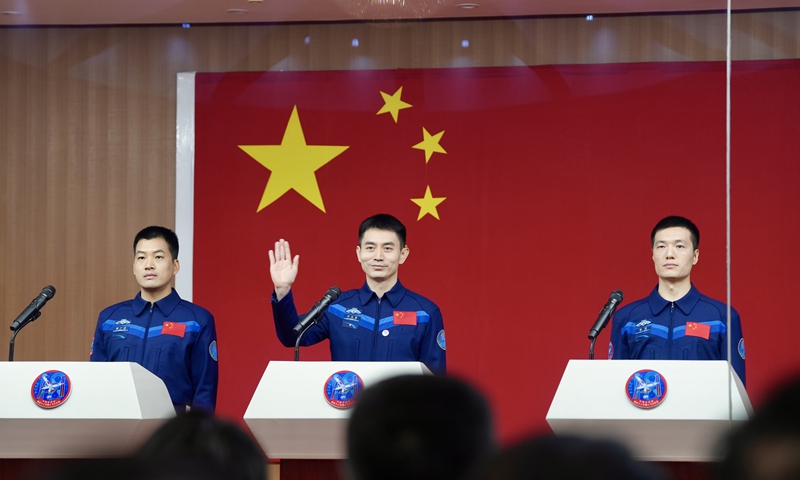Shenzhou-18 set for launch at 8:59 pm on April 25, marking China's 32nd manned flight into space

Ye Guangfu (C), Li Cong (R) and Li Guangsu, the three Chinese astronauts for the upcoming Shenzhou-18 spaceflight mission, meet the press at the Jiuquan Satellite Launch Center in northwest China, April 24, 2024. Photo: Fan Anqi/GT
China will launch the Shenzhou-18 manned spacecraft from Jiuquan Satellite Launch Center in Northwest China at 8:59 pm on Thursday, sending the new crew - Ye Guangfu, Li Cong, and Li Guangsu - to the Chinese Space Station, announced China Manned Space Agency (CMSA) at a press conference on Wednesday, which marks the country's ninth Space Day.
Shenzhou-18, China's first crewed mission this year, is the seventh batch of taikonauts to be sent to the Tiangong Space Station since its construction, and the third since it entered application and development phase. It also marks China's 32rd manned flight into space.
The crew members for the Shenzhou-18 manned spaceflight mission consist of taikonauts Ye Guangfu, Li Cong, and Li Guangsu, with Ye serving as the mission commander, CMSA spokesperson Lin Xiqiang said.
Ye from the second batch of selected taikonauts has previously participated in the Shenzhou-13 spaceflight mission, while the other two crew members from the third batch are embarking on their ever first space journey. All three were born in the 1980s.
"Currently, all preparations for the mission are progressing steadily. The Long March-2F Y18 rocket, poised to carry out this launch mission, is about to start fueling," Lin said.
After completing the orbital shift with the Shenzhou-17 members, the Shenzhou-18 crew will stay in the space station for about six months, during this period of time they will conduct space science and application experiments, and carry out two to three extravehicular activities and six cargo ingresses and egresses, installing space debris protection devices, as well as installing and retrieving external payloads and equipment.
Additionally, they will conduct science popularization activities, and carry out space experiments to further improve the station's operational efficiency.
Notably, the Shenzhou-18 crew will carry experimental equipment and related samples to conduct the first domestic in-orbit aquatic ecological research project. The project will focus on zebrafish and ceratophyllum demersum, aiming to establish a stable space self-circulating aquatic ecosystem in orbit to achieve a breakthrough in China's cultivation of vertebrate animals in space,
After entering orbit, the Shenzhou-18 spacecraft will adopt an autonomous rapid rendezvous and docking according to plan, and dock with the Tianhe core module's radial docking port some 6.5 hours later, forming a three-ship, three-module complex.
During their stay, the Shenzhou-18 crew will welcome the Tianzhou-8 cargo ship and the Shenzhou-19 crew, and are planned to return to the ground in late October this year.
Currently, the space station complex is in good condition, and all equipment is working normally, with the Shenzhou-18 crew in good spirits. Ground system facilities and equipment are operating stably, and all launch site preparations are ready to go.
Wednesday marks the ninth China Space Day. Fifty-four years ago today, China's first space satellite, Dongfanghong-1, was successfully launched from the Jiuquan Satellite Launch Center. At 11 am, the mission crew met with domestic and foreign media at this important birthplace of China's space industry.
At the press conference, Lin noted that for the next step, China will accelerate research and promote the participation of foreign astronauts and space tourists in flights to the space station.
While answering questions regarding the future plans for manned lunar exploration, Lin said that China's fourth batch of taikonaut selection is about to be completed. After joining the team, they will work together with current taikonauts to carry out the follow-up missions in the space station and achieve the goal of landing on the moon.
The Long March-2F carrier rocket is the country's first-generation manned carrier rocket since its maiden flight in 1999, and it has never stopped on the path of self-improvement.
Compared with the previous Long March-2F used in the Shenzhou-17 mission, the new rocket has undergone 32 technical improvements, making it safer and more reliable. The reliability assessment of the rocket has been increased from 0.9896 to 0.9903, and its safety assessment has reached 0.99996, according to information shared by rocket developers with the China Academy of Launch Vehicle Technology (CALT).
Since the space station started construction, the Long March-2F rocket has entered a normalized fast-paced launch state.
In order to quickly and stably send taikonauts into space, the rocket development team has continuously explored the optimization of the launch site preparation process. Now, the preparation process of the Long March 2F rocket has been reduced from 49 days in the early stage to 30 days, according to CALT.
Moreover, the development team has also used digital means such as remote measurement and control support systems to achieve real-time interconnection of rocket test data, making data interpretation more efficient and accurate. At the same time, the number of launch site personnel has been reduced by about 40 percent, further improving work efficiency.
As the country's only active manned launch vehicle, the Long March-2F rocket has been specially designed with a unique fault detection system and escape rescue system. Over the past 20 years, it has maintained a 100 percent launch success rate. Although the escape rescue system has never been used, researchers made numerous improvements and refinements behind the scene to better safeguard the taikonauts' safety.
